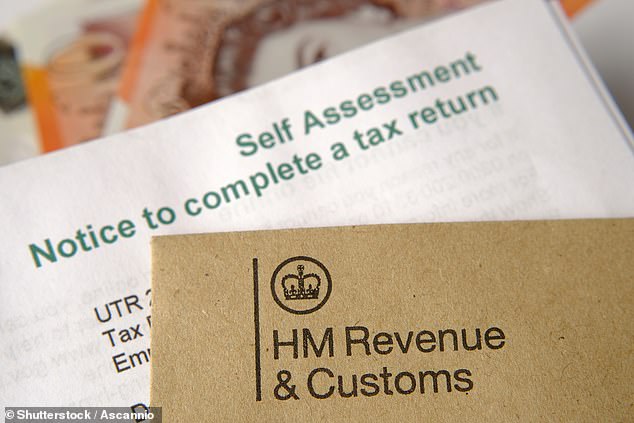Why having just £16,000 in savings could now plunge you into a tax tangle
Rising interest rates should be good news for savers.
Best-buy savings accounts – which have already topped 6 per cent – could rise further tomorrow when the Bank of England is expected to raise the key rate to 5.5 per cent for the 15th consecutive increase.
But millions of savers could be in for a nasty surprise. Now they finally earn a decent interest, the taxman collects an ever larger part of it back in the form of income tax.
Interest earned on savings is treated as income and taxed according to the marginal rate of income tax.
The taxman takes 20 percent of the basic tax payers, 40 percent of the higher tax rate and 45 percent of the additional tax rate.
Limits: Savers have Personal Savings Allowance, which means they can earn £1,000 or £500 interest tax-free for basic and higher rate taxpayers.
All savers have Personal Savings Allowance, which means they can earn £1,000 or £500 of tax-free interest for basic and higher rate taxpayers. Additional tax payers pay tax on all their interest.
Still, those deductions still look paltry as interest rates rise. Savers who have diligently built even modest nest eggs are now in a pinch.
Today, a basic rate taxpayer would break even with just £16,130 in the highest-yielding savings account, which is currently NS&I’s Guaranteed Growth Bond, which pays 6.2 per cent. A higher rate taxpayer would have a higher tax bill if they had more than £8,065 in the same account.
If savings rates rise further with tomorrow’s prime rate hike, savers will need even less in their accounts before they break their allowance.
Money Mail is calling on Chancellor Jeremy Hunt to double the Personal Savings Allowance to £2,000 to give savers a tax break.
We think it’s unfair that savers with relatively modest nest eggs see their income eroded by tax.
Savers should be rewarded – and encouraged – for their prudence and concern for their own financial future.
Since we launched our campaign in July, many readers have been in touch to share their support.
Geoff Dowdall, 76, from Essex, has relied on the income from his savings interest since he retired.

Petition: We’re calling on Chancellor Jeremy Hunt to double Personal Savings Allowance to £2,000
“I’m an OAP but I’m suddenly facing tax bills on my savings – which I’ve already paid tax on when I’ve earned them,” he says.
‘That can’t be fair. If I were allowed to keep my interest, I would use it – which would be good for the economy.
Christine Watson, 72, from Newcastle, says: “The government gives with one hand and takes with the other.
We should be happy that the state pension is going up thanks to the triple lock. But our incomes continue to be squeezed as we are dragged into paying more income tax and savings tax.
Readers also write in with numerous questions about the functionality of savings taxation.
We presented them to some of Britain’s top accountants and asked them for their tips on how to cut your bill.
Here are four pitfalls to avoid – and three tips to remember – from Robert Salter, director of tax consultancy Blick Rothenberg; Dawn Register, Tax Partner at BDO; and David Portman, director of certified public accountant Lubbock Fine.
1. You might get a SHOCK bill in 2026
Savers who are registered for PAYE will automatically pay savings tax through an adjustment to their tax code. This includes savers who have an employer or receive a state pension. All savings providers report the interest you earn to HMRC.
Be careful though – there’s likely to be a lag between when you earn interest and when it’s taxed.
If you violate the deduction between April of this year and next year, the tax will be collected retroactively through your tax ID for the entire year until April 2025.
Be prepared for your income to drop starting in April. If you are not registered for PAYE, you will need to pay your tax bill through Self Assessment. In this case, you will pay the bill later as well.
For example, you must pay the tax due for the tax year 2023-2024 by January 31, 2026. You can sign up for a self-assessment by calling HMRC’s income tax service on 0300 200 3300.
2. Prepare to announce the savings
If you have income of more than £10,000 a year from savings, dividends and investments, you must complete a personal income tax return.
For the tax year ending 5 April this year, you must register with HMRC by 5 October and submit a return and pay any tax by 31 January 2024.
However, you may have to file a return even if no taxes are due. Some people can earn up to £18,570 in savings interest-free (see tip 3 below).
However, you may have to file a return. If you don’t, you can be fined.
3. Beware of multi-year bonds
Savers rely on multi-year bonds to get a good interest rate for two, three or five years.
However, few people realize that some bonds pay interest in a way that results in a significantly higher tax bill than others.
This is because some collect all the interest earned each year and pay it all off at the end of the bond’s term.

If you have more than £10,000 a year from savings, dividends and investments, you will need to complete a self-assessment tax return
Savers with this type of bond are treated as if they received all of their interest in one tax year and are therefore more likely to breach the personal savings allowance for that year.
Others are treated as if the annual interest were paid every year rather than all at once – even though you won’t be able to access the interest until the end of the term.
In this case, you can take advantage of your personal savings benefits over several years, reducing your overall tax bill.
If you’re taking out a multi-year bond, make sure you check with your service provider about which loan you’re getting and how it might affect your bill.
4. Beware of the wrong amount
Until recently, few savers would have broken their personal savings allowance. But within a year, the amount of tax paid by savers will almost double from £3.4bn to £6.6bn this year, wealth platform AJ Bell estimates.
Accountants warn that this could prove to be an administrative nightmare for HMRC. The system relies heavily on HMRC correctly adjusting millions of tax codes – and is not known for its accuracy in this department.
Therefore, when you receive a letter or notice from HMRC that they have changed your tax code, check it carefully.
In some cases, it may change your tax code more than once in a single tax year.
When your tax code is changed, HMRC should send you details of how it made its decision and how much interest it thinks you will receive.
Check this notice to make sure you agree with HMRC’s calculation – and let them know if you don’t.
Couples who have a joint account should be especially vigilant. This is because HMRC should assume that each account holder will only receive half of the interest.
However, this system is open to error, so if you are in this position, you should ensure that you are only taxed on half of the interest on the joint account.
And the best tips for cutting the bill
1. Get the most out of Isas
Individual Savings Accounts (Isas) are much like any other cash savings account, except that your money is completely sheltered from tax.
You can invest up to £20,000 in Isas each tax year. Isas usually pay slightly lower interest rates than other savings accounts.
The current best buy rate is 5.79pc with a two year fix with Kent Reliance. However, you may be better off accepting a lower tax rate if it keeps your tax bill under control.
Check the best cash Isa prices in our savings tables

Haven: You can invest up to £20,000 in Isas each tax year. Isas usually pay slightly lower interest rates than other savings accounts
2. Reduce your bill as a couple
If you are a higher or additional rate taxpayer and your partner is a basic rate taxpayer, you can cut your combined tax bill by transferring your savings to your partner’s name.
There are also two other tax breaks for couples that can help. Only those who are married or in a relationship are eligible.
The first is the spousal allowance. If one person’s income is less than £12,570 in income tax relief and the other is a basic rate taxpayer, you can transfer 10 per cent of the personal allowance to the higher earner. This could save you up to £252 in tax per year.
The other is Married Couple Allowance, which is available if one of you was born before 6 April 1935.
The amount of tax you could save is between £401 and £1,037 a year, depending on your circumstances. Visit the website: gov.uk/married-couples-allowance.
3. Earn more if you have a small income
If you have no other income, you can earn up to £18,570 in interest before tax.
This consists of a combination of three benefits: a £12,570 Personal Benefit, a £1,000 Personal Savings Allowance and a £5,000 starter rate on savings.
Go to gov.uk/apply-tax-free-inter est-on-savings to find out more about how these benefits work.
- Do you have a question about the taxation of savings? Email r.rickardstraus@dailymail.co.uk
Some of the links in this article may be affiliate links. If you click on them, we may earn a small commission. This helps us fund This Is Money and keep it freely available. We do not write articles to promote products. We do not allow any commercial relationship to influence our editorial independence.
